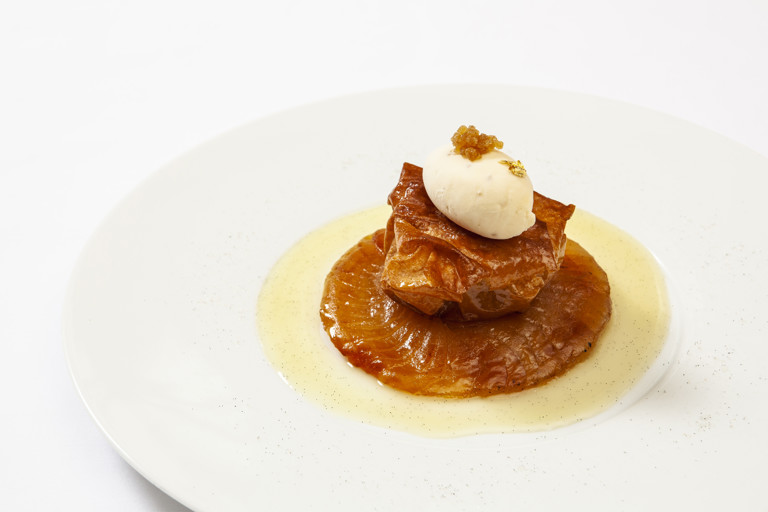Apple croustade
- medium
- 4
- 2 hours
An ideal dessert to prepare for autumn and winter, this recipe takes the incredible crisp and delicate texture of croustade pastry and pairs it with one of Raymond's favourite apple varieties.
'This famous croustade from southwest France features a rosace of Cox’s apples in their own coulis, crowned with the finest and flakiest caramelised pastry. I love it, even though it doesn’t originate from my region, and interestingly, the recipe has similarities with the legendary strudel. It does require patience and delicate handling, but it’s a highly rewarding dish and a wonderful treat for a special occasion. Should you decide not to attempt it, then come to Le Manoir during the autumn – it will be on the menu. I like to serve it topped with a scoop of apple sorbet or honey and ginger ice cream.'
Follow Raymond on Instagram, Twitter and Facebook. Recipe © Raymond Blanc.
Ingredients
Metric
Imperial
Croustade dough
To finish the dough
- 15g of clarified butter
- 30g of caster sugar
Apple rosace
- 30g of clarified butter
- 1/2 tsp Calvados, or brandy
- 10g of caster sugar
- 1/4 lemon, juiced
- 8 Cox’s Orange Pippin apples
Apple coulis
- 80g of Cox’s Orange Pippin apple, peeled and chopped
- 80ml of water
- 40g of caster sugar
- 10ml of lemon juice
- 1/2 tsp vanilla syrup
To serve
- 8g of crystallised stem ginger, chopped (optional)
- ice cream, or sorbet, in your flavour of choice
Equipment
- Stand mixer with dough hook
- 4 10cm tartlet tins
- Blender
- 14cm round moulds 4
Method
- 2 tbsp of grapeseed oil
- 20ml of warm water, at about 50°C
- 15g of clarified butter
- 30g of caster sugar
- 30g of clarified butter
- 1/2 tsp Calvados, or brandy
- 10g of caster sugar
- 1/4 lemon, juiced
- 80g of Cox’s Orange Pippin apple, peeled and chopped
- 80ml of water
- 40g of caster sugar
- 10ml of lemon juice
- 1/2 tsp vanilla syrup
- 8g of crystallised stem ginger, chopped (optional)
- ice cream, or sorbet, in your flavour of choice
Get in touch
Please sign in or register to send a comment to Great British Chefs.


